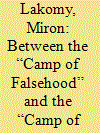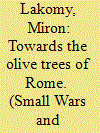|
|
|
Sort Order |
|
|
|
Items / Page
|
|
|
|
|
|
|
| Srl | Item |
| 1 |
ID:
188375


|
|
|
|
|
| Summary/Abstract |
This paper attempts to fill the gap in research and contribute to the academic debate on the online magazines of Daesh. Its primary objective is to identify and understand propaganda devices, which were exploited by the editors of “Dabiq” to influence its readers. In order to do this, the study utilized a classic framework of propaganda devices elaborated by the American Institute for Propaganda Analysis, which consists of seven methods: name-calling, glittering generalities, transfer, testimonial, card-stacking, plain folks, and bandwagon.
|
|
|
|
|
|
|
|
|
|
|
|
|
|
|
|
| 2 |
ID:
165305


|
|
|
|
|
| Summary/Abstract |
This article argues that video games have become a valid and increasingly significant means of jihadist digital propaganda. “Gaming jihad” has recently shown interesting alterations, mostly due to actions undertaken by the so called Islamic State and its cyber-partisans, which have discovered new ways of using this flexible and immersive medium. Similar to more conventional forms of its online propaganda, which have been imitated by other Islamist terrorist groups for years, the “Caliphate's” exploitation of electronic entertainment software may be a forerunner for the increased interest of other violent extremist organizations in this medium.
|
|
|
|
|
|
|
|
|
|
|
|
|
|
|
|
| 3 |
ID:
193085


|
|
|
|
|
| Summary/Abstract |
This article aims to map the online propaganda presence and activities of the Turkestan Islamic Party’s media arm—Islam Awazi (“Voice of Islam”). It also discusses its capabilities in terms of producing new releases and attracting online audiences. In order to reach these objectives, this study exploited a methodology which is a combination of open source intelligence techniques (OSINT) with limited content analysis. It argues that the Uyghur-oriented Islam Awazi’s (IA) propaganda strategy was primarily based on one standalone website, which constituted a central repository of its new productions. It was supported by several Telegram channels. However, open source intelligence investigation allowed other domains proliferating the IA’s productions, which were still accessible but abandoned at the time when this study was carried out, to be discovered. It also proved that the organization was capable of producing more than 160 propaganda releases between January and September 2020. Their viewership on the surface web was, however, quite limited. Finally, this study also outlines a peculiar connection between Islam Awazi’s websites and two networks of domains exploited by the cyber-criminal underground to distribute pornography and malware. This may be considered as a sign of an existing—and widely discussed by the academia—terror-crime nexus.
|
|
|
|
|
|
|
|
|
|
|
|
|
|
|
|
| 4 |
ID:
175743


|
|
|
|
|
| Summary/Abstract |
This paper attempts to understand the most evident propaganda methods and leading themes exploited in the recent issues of the Islamic State’s flagship Anglophone magazine Rumiyah to downplay its increasingly visible crisis. It argues that there are several leading methods of damage control utilized by Daesh. To begin with, a noticeable effort has been made to recover the “winner’s image” of the Islamic State with the use of card-stacking propaganda devices. This has been combined with the widespread promotion of martyrdom as an end-goal for all mujahidin, which is symbolized by the slogan: “one of the two good outcomes.” Finally, the crisis of the group has also been downplayed by a plethora of religion-related manipulation techniques and name-calling propaganda devices, utilized predominantly to exploit sectarian tensions.
|
|
|
|
|
|
|
|
|
|
|
|
|
|
|
|
| 5 |
ID:
179975


|
|
|
|
|
| Summary/Abstract |
This article attempts to fill a gap in research on the propaganda methods exploited in the Islamic State’s flagship online magazines, Dabiq and Rumiyah. Its major objective is to discover methods exploited by their editors either to convince readers to join the ranks of the Islamic State, or to partake in jihad in the form of violent actions against infidels. The article also attempts to understand the magazines’ modus operandi in terms of legitimizing the “Caliphate’s” violence against its enemies. In order to reach these goals, content analysis and comparative analysis were utilized. This article argues that while the legitimization of violence and call to violence was strongly emphasized in both magazines, there are significant differences in terms of recruitment messages. On the one hand, Dabiq prioritized this issue (e.g., through the promotion of hijrah). On the other hand, Rumiyah was much less interested in inciting followers to join its ranks in the Middle East. Instead, it focused on calling Ummah to participate in jihad against the infidels, especially in the form of lone-wolf terrorist attacks.
|
|
|
|
|
|
|
|
|
|
|
|
|
|
|
|
| 6 |
ID:
173844


|
|
|
|
|
| Summary/Abstract |
This paper aims to contribute to understanding how the last flagship magazine of the Islamic State - “Rumiyah” - attempted to influence and manipulate Internet users. Its primary objective is to analyze the propaganda methods exploited in all thirteen issues of this magazine. In order to do so this paper utilises content analysis to investigate “propaganda devices”, a concept developed by the American Institute for Propaganda Analysis. It argues that there were four predominant groups of propaganda devices exploited in this magazine. Two of them, i.e. name-calling and glittering generalities, were utilized to create and promote an artificial, black-and-white vision of the world, composed of the “camp of kufr” (camp of disbelief) and the “camp of iman” (camp of faith), embodied by the Islamic State. The third leading propaganda method, transfer, attempted to legitimize the actions and agenda of the “Caliphate” by using the authority of not only Allah, but also the Prophet Muhammad, his companions (Sahabah), as well as selectively chosen Islamic scholars. Finally, the bandwagon served as a means of creating a sense of community between the editors and readers. Other propaganda devices, such as testimonial or plain folks, played strictly secondary roles in the narration of the magazine.
|
|
|
|
|
|
|
|
|
|
|
|
|
|
|
|
|
|
|
|
|